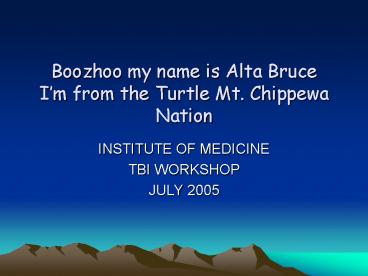Boozhoo my name is Alta Bruce I - PowerPoint PPT Presentation
1 / 13
Title:
Boozhoo my name is Alta Bruce I
Description:
Boozhoo my name is Alta Bruce I m from the Turtle Mt. Chippewa Nation INSTITUTE OF MEDICINE TBI WORKSHOP JULY 2005 Statement of problem (cont d) Among Native ... – PowerPoint PPT presentation
Number of Views:89
Avg rating:3.0/5.0
Title: Boozhoo my name is Alta Bruce I
1
Boozhoo my name is Alta BruceIm from the Turtle
Mt. Chippewa Nation
- INSTITUTE OF MEDICINE
- TBI WORKSHOP
- JULY 2005
2
Indigenous Peoples
- 566 federally recognized Native entities in the
United States - 200 Native languages and dialect
- 50 reside in urban areas
- 15 in rural remote non-reservation areas
- And 35 on reservation
3
- Of the total United States population, 2.5
million people, or .09, reported Native American
and Alaska native - An additional 1.6 million people reported Native
American and at least one other race - Thus 4.1 million people, or 1.5, reported Native
American alone or in combination with one or more
races (Ogunwole, 2000)
4
Statement of Problem
- Between 1992-1996, Indian Health Service, Tribal,
or contract care hospitals recorded 4,491 TBI
related hospitalizations among AI/AN with an
average stay of 4.7 day - The major cause of hospitalizations for TBI were
MVC at 24 - Assaults 17
- Falls 16
5
Statement of problem (contd)
- Among Native Americans the incidence of TBIs are
believed to be underestimated. This may be due to
inaccurate reporting, people not seeking and/or
receiving medical attention, and a lack of
awareness. Thus, a need for research and stats
are needed to address this paucity of data
pertaining to Native Americans specifically with
traumatic brain injuries. - Many Native Americans are not being served under
current health care system - Immediate or extended family members are the
primary caregivers without financial resources - Currently Native American Tribes are not
receiving Federal or State TBI dollars or services
6
- The highest number of hospitalized TBIs among
AI/AN were in the Northern Plains and Alaska
(IHS 1999) - Compared to all other racial groups combined,
AI/AN experienced assault related TBI nearly
twice as often (20.9 vs. 10.3) conversely, the
occurrence of falls in AI/AN was much less (19.3
vs. 33.2 (IHS 1999)
7
Indigenous Peoples Brain Injury
AssociationIP-BIA
- The IP-BIA was founded in 1994 and is a
grassroots organization composed of survivors,
families, and service providers working together
to promote the healing process through a holistic
approach with modern and traditional healing
practice - A traditional strength of the Native
American/Alaska Native community has been the
extended family - Family is the Native American clients are
traditional the backbone of their lives. They
rely on them for emotional and many times
financial support (Marshall Johnson, 1996)
8
IP-BIA contd
- Beginning in 1994 -2003 IP-BIA was able to have a
conference for all tribes in North Dakota,
Montana, South Dakota, and Canada with TBIs - The purpose was to gather Indigenous Peoples
with TBIs to assist in advocating, tracking,
educating, and most importantly provide support
to survivors, families, and service providers - In 2003 the First National Native American Summit
on Traumatic Brain Injury sponsored by Heath
Resources Service Administration (HRSA)
9
Native American Summit on TBI
- First step in getting perspective and direction
from Native Americans affected by TBI - Native and Non-Native professionals working with
and in Native communities
10
Native American Summit 2003
- Through this year long planning process, it
became clear that Native Americans with TBI and
their families have many needs to address - Indigenous people from the Plains, Woodlands,
Northwest, and Southwest cultural regions of the
nation were in attendance
11
Native American Summit 2003
- In addition policymakers, medical, research, and
service agencies were all in attendance - Activities indicative to Native Americans culture
were incorporated such as an opportunity to
participate in a sweat lodge and talking circles
12
Where do go from here?
- In conclusion, stories were shared, gap and
overlaps in services were discussed, policy
makers were informed and the diverse needs of
Indigenous peoples with brain injury were
identified - To improve the delivery and the quality of
services to establish favorable policy and
legislation and GUARANTEE SUSTAINED FINANICAL
SUPPORT
13
MiigwetchAlta M. BruceTurtle Mountain Band of
ChippewaIP-BIA Founder704 Berg StreetRolette,
ND 58366alta.bruce_at_ihs.gov(701)
477-8495(701)246-3368































